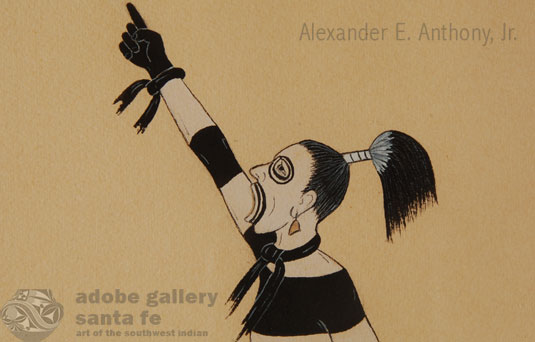Untitled Painting of a Koosa or Koshare Clown [SOLD]
+ Add to my watchlist Forward to Friend
- Category: Paintings
- Origin: San Ildefonso Pueblo, Po-woh-ge-oweenge
- Medium: casein on paper
- Size:
11-⅜” x 7” paper;
17-⅛” x 12-¾” framed - Item # C4071 SOLD
It is generally accepted that the first pueblo painters emerged from the very small pueblo of San Ildefonso Pueblo in the year 1900. At that time, San Ildefonso had a population of 138 Tewa-speaking Native Americans and one non-native resident: elementary school teacher Esther Hoyt, who arrived at San Ildefonso in 1900 and departed in 1907. Hoyt provided her students with watercolor paints and paper and told them to paint pictures of pueblo ceremonial dances. At the time, the government's policies were intended to discourage students from embracing their Native culture. Why would a government teacher go against government policy? Perhaps she was looking for a way to understand her pupils through their lifeways and to win their confidence so she could comply with government policies. Alternately, she perhaps did not agree with government policy and chose to teach in her own manner.
In the first few years at the elementary school, Hoyt had a class of about 18 students between the ages of 5 and 12. Her first-year class included Tonita Peña, Alfredo Montoya, Alfonso Roybal, Santana Roybal (later, Martinez), Abel Sanchez, and Romando Vigil. These artists would go on to become known as the "San Ildefonso School" or "San Ildefonso Self-Taught" group-the first known Pueblo Indian painters. Many of them went on to enjoy successful careers as painters, and a few of them are among the most highly collectible native artists. Luis Gonzales (1907-1990) Wo-Peen - Medicine Mountain was part of this movement, though it is unclear whether or not he actually attended the school alongside the aforementioned artists.
Wo-Peen painted most prolifically during the 1920s, exhibiting widely on both the West and East coasts. Clara Lee Tanner's Southwest Indian Painting: A Changing Art describes his abstract leanings before circling back to his strength as a flat-style traditionalist: "Many esoteric and symbolic paintings were executed in abstract style by Wo-Peen. Often Wo-Peen used color straight from the palette, frequently employing absolute balance in design in varying color arrangements... Withal, Wo-Peen's painting is purely Indian in the usual two-dimensional and flat technique... Outstanding characteristics are fine outlining and a delicacy in his brush work, regardless of subject matter. Also typical is his absolute balance in composition but not in color." He stopped painting during the 1960s, after losing his hand in a hunting accident. Wo-Peen passed away in 1990.
This excellent untitled piece shows that, although lesser known than most of his contemporaries, Wo-Peen was a first-rate creator of flat-style images. Here, we see a Koosa clown-the Pueblo Indians' humorous provider of social commentary-pictured in profile. Marching with his finger pointed upward and his mouth agape, the clown appears to be in the middle of a performance. These performances, although humorous, serve important purposes, including the reinforcement of taboos and the communication of cultural traditions. Whatever he's doing here he appears to be doing with great conviction. Wo-Peen's outlines-as noted in Tanner's book-are excellent, framing the clown's lanky body in an incredibly realistic fashion. His color choices-black and white, mostly, with a few small uses of a tan hue-are bold and strong. The composition, free of background or ground plane, is excellent. This excellent painting suggests that, had he not had his career cut short by an injury, Wo-Peen might have gone on to become one of the great Pueblo painters.
The Untitled Painting of a Koosa or Koshare Clown is framed in a simple, beautiful wood frame. It is signed in its lower right corner. Attached to the back is a board, onto which the painting might have originally been mounted. "Koshare 20" is scrawled on the board (back), barely legibly, in pencil.
Condition: excellent condition
Provenance: from the collection of a Santa Fe resident
Recommended Reading: Southwest Indian Painting: A Changing Art by Clara Lee Tanner

- Category: Paintings
- Origin: San Ildefonso Pueblo, Po-woh-ge-oweenge
- Medium: casein on paper
- Size:
11-⅜” x 7” paper;
17-⅛” x 12-¾” framed - Item # C4071 SOLD



